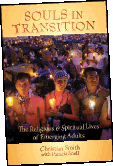 |
Reviewed By William Damon, a professor at Stanford University and the author of The Path to Purpose: How Young People Find Their Calling in Life.
Souls in Transition: The Religious and Spiritual Lives of Emerging Adults
Christian Smith, Patricia Snell
Oxford University Press
368 pages. $24.95 hardcover.
Religious life is such a huge part of the American experience that it is difficult to grasp in its actual present-day contours. We know the historical record best. European settlers from England and Spain came to America on missions to find and promote God’s will, and many successive waves of immigrants brought with them their own brands of religious devotion.
For much of our history, the very idea of America has been imbued with an aura of sacredness that poets and politicians have long cited. As for today, we know that the vast majority of Americans – I have seen figures as high as 90 percent – say they believe in God. This places us far above Europe, Asia and many other parts of the world in declarations of religious faith.
But what we do not know – or at least have only a hazy sense of – is what these declarations amount to in terms of the real quantity and quality of religiosity in America today. How deep do the beliefs of the faithful go? What do they experience, and how do they pursue their beliefs? Perhaps the most blurred spot on our looking glass concerns the young. Here, because of the obvious significance of youth religiosity to the future of all faith traditions, speculation abounds. Our mass media accounts of youth religiosity have tended toward the hyperbolic: The conventional wisdom has been that, in mainline and evangelical faith communities alike, young people are dropping out in droves.
Now, in Christian Smith and Patricia Snell’s Souls in Transition: The Religious and Spiritual Lives of Emerging Adults, we have a source that offers us a satisfying and trustworthy account of how religion is actually experienced among today’s young. This is a work of serious scholarship that does not aim for glib generalizations, easy conclusions or dramatic overstatements. Instead, this gem of a book probes deeply into the sentiments of a select number of individual youths and broadly across the spectrum of a large sample, arriving at a rich set of findings that are informative in their detail and realistic in their complexity.
For example, the authors resist the temptation to weigh in on the usual hot-button question of whether our young are less religious than youngsters of the past. Although the book’s findings indicate that young adults now are less religious than older adults, the authors point out that they “do not appear to be dramatically less religious than former generations of emerging adults have been, at least dating back to the early 1970s.”
Most revealing, their findings show a highly mixed pattern of belief and non-belief among the young. This generation is fragmented, containing wide variations in perspectives among its members. No single designator (Generation X, Y, Z, Millennial, whatever) can sum it up. It is a tribute to the integrity of this book that the authors do not attempt a simplistic description of this sort. Rather, they give us the whole picture, in all of its intricacy and indeterminism.
Like any valid social-science compendium of findings, the book replicates much of what has been reported elsewhere with respect to the development of emerging adults in today’s world. The fragmented nature of this generation, their delay in reaching all the typical milestones of adulthood, and the constant influence of parents (young people now trust folks over 30!) all have been extensively discussed in much prior literature on youth today.
The book would appeal to a broader readership if it had placed its own findings in the context of this already established knowledge. Instead, the authors stick to their own story and leave it to others to synthesize this with an overall account of contemporary youth development. This omission makes the book challenging reading for those outside the social-science community, but it does not diminish the scholarly value of this careful and ground-breaking study.
























